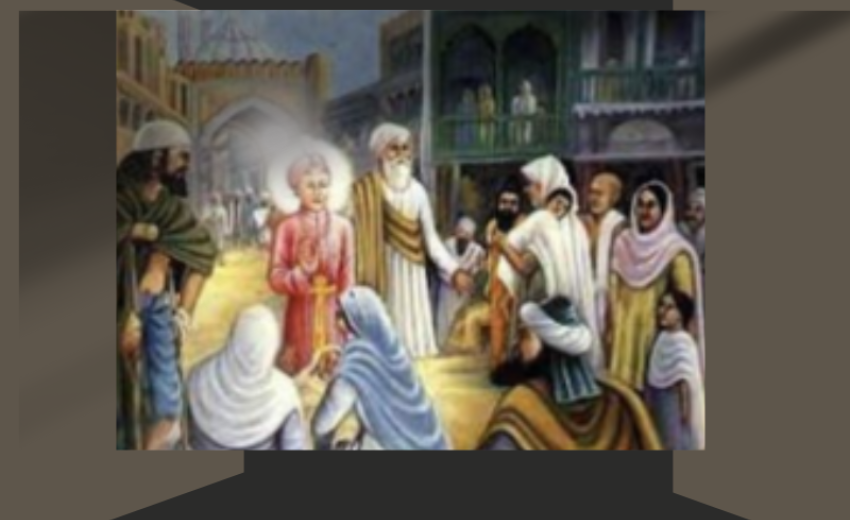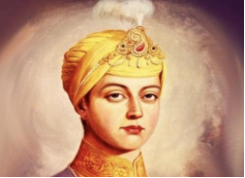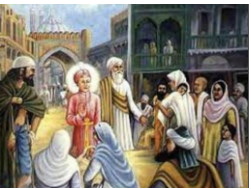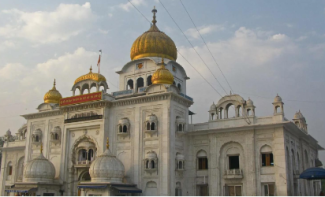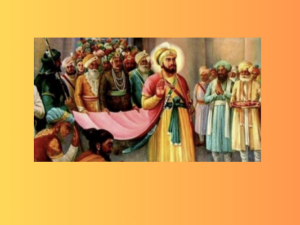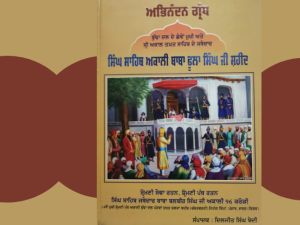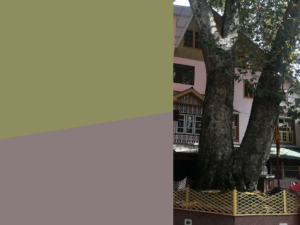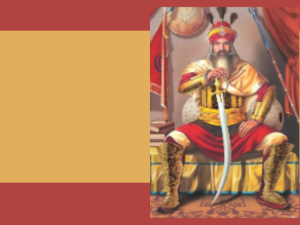According to Bhai Nand Lal Goya (a great poet in the court of Guru Gobind Singh ji )
Hum Har Krishan Amada Sar-Buland
Azo Hasil Amadi Har Mostmand
(That's the head-glorious Harkrishan,
From which the desire of every needy person is fulfilled.)
Early Life:
Guru Har Rai Sahib had two sons and one daughter: Baba Ram Rai Ji, Guru Harkrishan Ji, and daughter Bibi Roop Kaur Ji. Guru Har Krishan Sahib was born on July 20, 1652, in Kiratpur Sahib to father Guru Hari Rai Sahib and mother Mata Sulakhni Ji. During his childhood, Guru Har Krishan Sahib displayed remarkable virtues and talents. The education of the three children of Guru Hari Rai Sahib was entrusted to the supervision of Dewan Dargah Mall. Guru Sahib followed in his father's footsteps and always had armed Singhs accompanying him. Guru Hari Rai Sahib thoroughly tested his children and found that only Harkrishan Sahib was worthy of becoming the eighth Nanak. However, the elder son, Ram Rai, decided to alter the Bani (teachings) of Guru Nanak Sahib before Emperor Aurangzeb in Delhi. As a result, Aurangzeb granted Ram Rai a Jagir (land grant) in Dehradun. Upon hearing this news, Guru Har Rai Sahib was deeply saddened by his elder son's lack of truth and courage. The Gurus declared Ram Rai ineligible for the Guruship. Guru Sahib sent a message to Delhi, instructing Ram Rai not to show his face. Although Ram Rai later came to seek forgiveness from Guru Sahib, he remained deprived of the Guruship. Ram Rai stayed in Kiratpur Sahib for some time and later went to Delhi with Aurangzeb. During Ram Rai's stay in Delhi, Guru Har Krishan Sahib transferred the responsibilities of Gurgaddi to Guru Tegh Bahadur Sahib. The exact date of Guru Har Krishan Sahib's ascension to the Guruship is clearly mentioned in the "Guru Kian Sakhis." Guru Har Krishan Sahib left this mortal world on March 30, 1664, after instructing Guru Tegh Bahadur Sahib to assume the responsibilities of Gurgaddi.
Testing times, the fall of Masands and the rise of Baba Ram Rai
During a tumultuous period, the influence of Masands declined, and Baba Ram Rai rose to prominence. In February 1660, Emperor Aurangzeb returned to Delhi and became concerned about the growing power of Sikhism in Punjab. To counter this, he invited Guru Hari Rai Sahib to Delhi, but the Guru sent his elder son, Baba Ram Rai Ji, to his place and proceeded to Kashmir via Sialkot, where he stayed for approximately four months. This move by Aurangzeb marked his initial success against the Sikh community. However, Baba Ram Rai Ji made a significant effort to alter the teachings of Guru Nanak in order to maintain his favor with the royal court, with the support of Gurbakhsh, a Masand from Delhi. As a result, Aurangzeb granted Baba Ram Rai Ji a jagir (landed estate) in Khurwadi (Dehradun) to widen this divide.
Following the transition of Guruship from Guru Hari Rai Sahib to his younger son, Guru Harikrishna Sahib, the Sikh community faced a challenging period. Brahmins, who were fixated on caste distinctions, had long held animosity toward the Guru-ghar. They saw an opportunity for the resurgence of Brahminical worship. Baba Ram Rai's acquisition of the jagir was only fueled by their hopes. Aurangzeb, in particular, was optimistic when the child Guru Har Krishan Sahib assumed the Guruship.
The Masand tradition was established by Guru Arjan Sahib, and it contributed to the growth of the Sikh community, which spread across distant and scattered regions. Now, it was time to test the loyalty and integrity of the knowledgeable Sikhs for the propagation and expansion of Sikhism. Each Sikh would contribute a portion of their earnings as tithes, which would be sent to the central treasury of the Guru Ghar through the Masands. This responsibility became increasingly significant, and the fame of the Masands grew accordingly. Unfortunately, some individuals fell into the trap of self-glory and delusion, leading them to deviate from the Guru's teachings.
Maintaining a secret alliance with the mighty Mughal Empire was no small matter. Certain Masands persuaded Baba Ram Rai to establish this alliance, including Masand Gurbakhsh from Delhi. They convinced Baba Ram Rai that making minor alterations to the Guru's Bani (teachings) would have no adverse effects. Consequently, his authority within Sikhism waned, and he was stripped of the vital responsibility of Gurgadi.
According to various sources, the practice of Chhadyantar (altering the Guru's Bani) persisted among some Masands. Sikh history attributes the pioneering role in this practice to a Masand named 'Gurdas.' Baba Ram Rai Ji complained to Aurangzeb about the injustice done to him, seeking the king's intervention to reclaim his rights. To pique the emperor's interest, Masand Gurdas remarked that a five-year-old Guru would be unable to govern the Sikh community effectively.
Cycle of Brahmins :
Guru Nanak Ji observed that the root cause of suffering for the poor people of India lay within three factions: Brahmins, Kshatriya workers, and Turk rulers. He repeatedly exposed their atrocities and provided courage to the poor. The subsequent Gurus followed the same path, gradually alleviating the influence of these factions on the people.
When Guru Har Krishan Sahib, the Eighth Jot, assumed the Guruship as a child, the local Brahmins believed that their influence would be restored. These cunning Brahmins often took advantage of opportunities to mislead the people, claiming that the Guru's abode was now quiet. Sikh history recounts incidents where the poor, who typically suffered from hunger, weakness, and diseases, were led astray by the clever Brahmins. These Brahmins would identify sick or distressed individuals near Kiratpur and tell them to go to Guru Nanak's house, where they would be healed.
According to Sikh chronicles, one day Guru Har Krishan Sahib was riding in a palanquin for a walk when a leper, sent by the Brahmins, approached and pleaded for a cure. The purpose of Guru Nanak's abode was to liberate the poor from the clutches of the Brahmins. Guru Ji understood that the common, impoverished people should not fall into the trap of the Brahmins again. Thus, the child Guru gave his handkerchief to the "Leprosy Brahmin" to wipe his hands and mouth and instructed him to spread the handkerchief over his village, claiming that everything is available at Guru Nanak's house. The leper agreed, and this trick exposed the deceit of the Brahmins, further enhancing the magnificence of the Guru's abode.
Another incident involving a Brahmin occurred in the village of Panjokhra when Guru Harikrishna Sahib was invited to Delhi by the royal court. During his one-night stay in Panjkhera, a Brahmin named Lal Chand, who boasted his knowledge of the four Vedas, six Shastras, eighteen Puranas, and twenty-seven Simritis, learned that the Sikhs considered Guru Harikrishna Sahib as the eighth Nanak. Lal Chand, intrigued, believed that if Guru Harikrishna Sahib truly embodied Krishna, he should recite the words of the Gita with its meaning.
Pandit Lal Chand arrived at the Guru's court carrying the book of the Gita on his shoulder, determined to recite it with the meaning. To his surprise, he encountered an aged Guru with attendants fanning him with chavar. Satguru smiled upon seeing Pandit Lal Chand and said, "Learn, my brother! Let him come forward. He has come to discuss the Shastra-artha with us." Pandit Lal Chand, being older, understood that the child Guru possessed divine insight and had understood his thoughts. Satguru instructed Dewan Dargah Mall to inform Pandit Ji that Guru Sahib would not interpret the scriptures himself but through someone else. They were to bring an illiterate commoner for that purpose. By the order of the venerable Guru, the scriptures would be interpreted through this elderly individual.Upon hearing this, Pandit Lal Chand summoned a man named Chhaju Ram Jhale from the village. Chhaju Ram stood before the Guru and Guru Sahib, looking at him, said, "Pandat Chhaju Ram Ji, please sit." Chhaju Ram saluted Guru Sahib and took a seat.
Satguru placed his stick on Chhaju Ram's head, endowing him with the ability to see the past, present, and future. Guru Sahib then instructed Chhaju Ram to explain the meanings of Geeta.
Departure to Delhi :
The historical account is related to the Guru Har Krishan Sahib. It describes the departure of Baba Ram Rai to Delhi, the arrival of Diwan Paras Ram from the Delhi Darbar to Guru Har Rai's residence in Kiratpur Sahib, and the subsequent visit of Guru Har Krishan Sahib to Delhi. It mentions the interactions between Guru Har Krishan Sahib, Baba Ram Rai, and Emperor Aurangzeb.
The narrative emphasizes the respect and admiration Emperor Aurangzeb had for Guru Har Krishan Sahib and his desire to meet him. Baba Ram Rai, while attending the royal court, explains to the king that the Guru is not a personal possession but the successor to Guru Nanak Sahib and that they should be subject to his authority.
The presence of various individuals such as Bhai Ani Rai, Bhai Jasu, Bhai Ganga, Bhai Hajuri, Bhai Nihchalu, Diwan Dargah Mall, Kanwar Ram Singh, Gurbakhsh, Bhai Mani Ram, and others during these events.
Entering Rasaina Nagar
Guru Har Krishan Sahib visits the bungalow of Raja Jai Singh Ambri in Rasaina Nagar. The queen, Pushpa Devi, decides that she will accept Guru ji as the form of Sri Krishna if he sits on her lap first. She disguises herself as a maidservant and removes her royal attire for the examination. Guru Har Krishan Sahib, being omniscient, understands her intentions and goes to her lap first. He acknowledges her devotion and says, "Mother! You have remembered what you desired, and I have come." Pushpa Devi is filled with joy and accepts Guruji's Sikhi.
News of Guru Har Krishan Sahib's arrival reaches Baba Ram Rai ji, who visits the bungalow and pays respects to both the mothers and Guruji. Meanwhile, Guru Teg Bahadur Sahib travels from Patna to Punjab with Mata Nanki Ji, Mata Harin Ji, and others. They stop at Bhai Kalyan Sikh Dharamshala, where devotees come to visit them. On the 21st of March 1664, they reach Raja Jai Singh's bungalow in Saina Nagar. Guru Teg Bahadur Sahib expresses condolences to Guru Har Rai Sahib and learns about Baba Ram Rai's visit to Delhi.
Guru Teg Bahadur Sahib advises Baba Ram Rai not to rely on logic and reminds him that while Baba Ram Rai has been to Delhi many times, it is Guru Har Krishan Sahib's first visit. Guru Teg Bahadur Sahib entrusts Guru Har Krishan Sahib well-being to Baba Ram Rai and departs for Mader Desh (Punjab), where they will stay in Bakala Nagar. Guru Teg Bahadur Sahib arrives in Bakala, a famous city in Majha, and delivers sermons on Nam-Bani. The congregation celebrates their arrival by lighting Deepmalas (rows of lamps) at night. The news of Guru Teg Bahadur Sahib's arrival spreads, and devotees flock to Bakala Nagar, creating a lively atmosphere.
Selfless Sewadars:
There were numerous sewadars (volunteers) dedicated to serving the Guru. Some of the selected sewadars were Dewan Dargha Mall, Bhai Mehn, Bhai Mani Singh, Bhai Gurbax, Bhai Gurdas, Munshi Kalyan Das, Bhai Dariya, Bhai Jugu Chuhan, Bhai Nanu Singh Dilwali, Bhai Sangat, and many others.
Gurdwaras, Shrines, and Monuments:
When Guru Har Krishan Sahib traveled to Delhi upon a royal invitation, he visited several cities during his journey. Along the way, Guru Sahib encouraged people to preach the religion and improve the economic conditions of the people. As a result, the Sikhs of Guru Sahib built several gurdwaras, shrines, and towns in his memory. Some of these include:Ambala, Karnal, Kiratpur Sahib, Kurukshetra, Thanesar,
Delhi, Panipat, Punjukhera, Ropar, Banur. These locations hold significance in Sikh history and are associated with the life and teachings of Guru Har Krishan Sahib.
Hukamnama
Hukmanama is the rare capital of the Sikh community. An edict of Guru Harikrishna Sahib is available to the Khalsa Panth. A copy of it existed in the Sikh Reference Library, Amritsar before June 1984. This edict was the Jog of the Sangat Patan (Faridkot) by the permission of the eighth Guru Harikrishna Sahib. Its original words are:
“Lord Satguru
It is the permission of Shri Guru Har Krishan Jiu, Bhai Ani Rai, Bhai Jasu, Bhai Ganga, Bhai Hajuri, Bhai Nihchalu, and Sarbat Sangat of Patan. All the intentions will be fulfilled. Keep sending gifts. Sangat keeps coming to Dharamsala. Performing Aarti is the true happiness of Sri Guru .”
Guru ji merged with eternal light
Guru Har Krishan Sahib, the eighth Guru of the Sikhs, played a significant role in helping and serving people during a smallpox outbreak in Delhi in 1664. Despite the risk to his own health, Guru Sahib selflessly provided assistance to the sick, suffering, and poor individuals affected by the epidemic. According to historical accounts, Guru Har Krishan Sahib eventually contracted smallpox, and his condition worsened day by day. On the fifth day of his illness, he instructed Baba Ram Rai to bring five paise naliyer lao and touched it, stating that the Guru of the Sikh Sangat after him would be Baba Sri Tegh Bahadur Ji of Bakala. He then merged into the eternal light of Akal Purakh, signifying his spiritual union with the divine.
Following Guru Sahib's passing, his body was cremated on the bank of the Yamuna River near Bhagalpur City by Baba Ram Rai, Diwan Dargah Mall, and other Sikhs. Mata Basi Ji, Guru Sahib's mother, then called upon Bhai Gurdas (son of Bhai Bahl) to recite from the Guru Granth Sahib. The news of Guru Sahib's passing was conveyed to Punjab by Diwan Dargah Mall and Munshi Kalyan Das, who first informed Bibi Roop Kaur in Kiratpur Sahib and later informed Guru Tegh Bahadur Sahib in Bakala. Mata Basi Ji, along with Diwan Dargah Mall and other Sikh Sangat from Delhi, arrived in Bakala in August 1664 to meet Guru Tegh Bahadur Sahib, who had been residing there for five months. The Sikhs requested Guru Sahib to assume the role of the Guru, and he imparted words of patience to the mothers who had lost Guru Har Krishan Sahib.
A grand fair was held in Bakala during the Amavasya of the Bhadarva month, attracting Sangats from various places. Baba Arjani from Goindwal, Bhai Garhian and Bhai Gurditta Randhawa from Ramdas Nagar, Baba Deep Chand and Nand Chand from Kiratpur Sahib, and Baba Ram Rai from Garhwal Desh were among those who attended. The Sangats from Delhi, including Mata Basai Ji, performed Pachavali together. During this time, Makhan Shah Banjara, accompanied by his wife and sons, arrived with seals as an offering to Guru Tegh Bahadur Sahib. After presenting the seals, Makhan Shah exclaimed, "Forget it, Sangat, Guru Ladho Ray" (I have found the Guru).
Bhai Nand Lal, a renowned poet and a devotee of the Gurus, elaborated on the qualities of Guru Har Krishan Sahib, highlighting his mercy, grace, and divine connection.
“His eighth kingdom is the crown of his devoted and pure lovers and the government of his beloved ones. His pious miracles are world famous and the light of his pious presence illuminates the truth. The special and the near are sacrificed to him, and the pure and holy sacrifice at his door. There are select men from the three peoples and six sides who praise his many authentic and firm qualities and those who choose the scraps left from the anchor of his glories are not included in any number or enumeration. He is associated with the good end and truth.
Guru Har Krishan is the personification of mercy and grace, the most praised of God's special close friends. Between him and God there is only a veil of a leaf,
His entire existence is the blessings of God. All his followers are in question of divine favors, the earth and the world are all obeying his commandments. By His grace both the worlds succeed, By his grace the sun shines in every particle. His protection is a great blessing for all special loved ones, from the underworld to the sky, all are obedient to him.”

